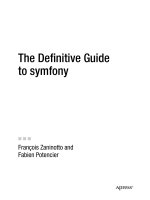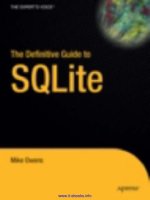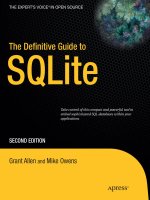The Definitive Guide to Jython doc
Bạn đang xem bản rút gọn của tài liệu. Xem và tải ngay bản đầy đủ của tài liệu tại đây (11.16 MB, 545 trang )
Juneau
Baker
Ng
Soto
Wierzbicki
The Definitive Guide to
Jython
Companion
eBook Available
this print for content only—size & color not accurate
CYAN
MAGENTA
YELLOW
BLACK
PANTONE 123 C
BOOKS FOR PROFESSIONALS BY PROFESSIONALS
®
The Definitive Guide to Jython:
Python for the Java
™
Platform
Dear Reader,
With Jython you enjoy the increased productivity and clarity of Python, and
the ability to integrate with existing Java™ libraries. You get the best of both
worlds: the elegance of Python, and the enterprise-readiness and maturity of
the JVM. The Definitive Guide to Jython explores the Python programming lan-
guage from the ground up, pointing out along the way details that are specific
to Jython. If you are unfamiliar with the Python language, then you can get
started here, but you will also learn about the differences between Jython and
standard CPython as you go.
Once you have the basics of the language, you’ll want to put it into use. This
book covers a variety of topics which will help you harness the power of Jython.
You will learn how to develop dynamic applications and scripts, and access data-
bases from Jython to build powerful database applications. Fundamental to get-
ting the most out of Jython is Java integration, and this book encourages you to
use Java within Jython code as well as Jython within Java code.
Jython has matured a lot between the last couple of versions and it is now
compliant with modern versions of the Python language. This means that you
can now take advantage of Python frameworks such as Django and Pylons, which
are both covered in this book. We will also provide you with a foundation to begin
using Java Servlet and Java Swing technologies with Jython.
We hope you enjoy this book and that it helps Jython to become as useful to
you as it is to us!
Josh Juneau, Jim Baker, Victor Ng, Leo Soto, and Frank Wierzbicki
US $54.99
Shelve in:
Java, Python
User level:
Beginner – Intermediate
www.apress.com
Available online at
www.jythonbook.com
SOURCE CODE ONLINE
Companion eBook
See last page for details
on $10 eBook version
ISBN 978-1-4302-2527-0
9 781430 225270
5 54 9 9
RELATED TITLES
spine = 1.03125" 544 page count
Josh Juneau, Jim Baker, Victor Ng,
Leo Soto, Frank Wierzbicki
Foreword by Ted Leung
Enjoy the power and flexibility
of Python on the JVM
Covers
Jython 2.5
The Definitive Guide to
Jython
Python for the Java
™
Platform
THE EXPERT’S VOICE
®
IN SOFTWARE DEVELOPMENT
www.it-ebooks.info
www.it-ebooks.info
The Definitive Guide to
Jython
Python for the Java™ Platform
■ ■ ■
Josh Juneau, Jim Baker, Victor Ng, Leo Soto, Frank
Wierzbicki
www.it-ebooks.info
■ CONTENTS AT A GLANCE
ii
The Definitive Guide to Jython: Python for the Java™ Platform
Copyright © 2010 by Josh Juneau, Jim Baker, Victor Ng, Leo Soto, Frank Wierzbicki
All rights reserved. No part of this work may be reproduced or transmitted in any form or by any means,
electronic or mechanical, including photocopying, recording, or by any information storage or retrieval
system, without the prior written permission of the copyright owner and the publisher.
ISBN-13 (pbk): 978-1-4302-2527-0
ISBN-13 (electronic): 978-1-4302-2528-7
Printed and bound in the United States of America 9 8 7 6 5 4 3 2 1
Trademarked names may appear in this book. Rather than use a trademark symbol with every
occurrence of a trademarked name, we use the names only in an editorial fashion and to the benefit of
the trademark owner, with no intention of infringement of the trademark.
Java™ and all Java-based marks are trademarks or registered trademarks of Sun Microsystems, Inc., in
the US and other countries. Apress, Inc., is not affiliated with Sun Microsystems, Inc., and this book was
written without endorsement from Sun Microsystems, Inc.
President and Publisher: Paul Manning
Lead Editors: Steve Anglin, Duncan Parkes
Technical Reviewers: Mark Ramm, Tobias Ivarsson
Editorial Board: Clay Andres, Steve Anglin, Mark Beckner, Ewan Buckingham, Gary Cornell,
Jonathan Gennick, Jonathan Hassell, Michelle Lowman, Matthew Moodie, Duncan Parkes,
Jeffrey Pepper, Frank Pohlmann, Douglas Pundick, Ben Renow-Clarke, Dominic Shakeshaft,
Matt Wade, Tom Welsh
Coordinating Editor: Mary Tobin
Copy Editor: Tracy Brown Collins
Indexer: BIM Indexers and e-Services
Artist: April Milne
Cover Designer: Anna Ishchenko
Distributed to the book trade worldwide by Springer-Verlag New York, Inc., 233 Spring Street, 6th Floor,
New York, NY 10013. Phone 1-800-SPRINGER, fax 201-348-4505, e-mail , or
visit .
For information on translations, please e-mail , or visit .
Apress and friends of ED books may be purchased in bulk for academic, corporate, or promotional use.
eBook versions and licenses are also available for most titles. For more information, reference our
Special Bulk Sales–eBook Licensing web page at
The information in this book is distributed on an “as is” basis, without warranty. Although every
precaution has been taken in the preparation of this work, neither the author(s) nor Apress shall have
any liability to any person or entity with respect to any loss or damage caused or alleged to be caused
directly or indirectly by the information contained in this work.
This book is available online under the Creative Commons Attribution-Share Alike license
( You can read the book at .
www.it-ebooks.info
■
iii
Contents at a Glance
Contents at a Glance iii
Contents v
Foreword xix
About the Authors xx
About the Technical Reviewers xxii
Acknowledgments xxiii
Introduction xxvi
Part I: Jython Basics: Learning the Language 1
■ Chapter 1: Language and Syntax 3
■ Chapter 2: Data Types and Referencing 25
■ Chapter 3: Operators, Expressions, and Program Flow 59
■ Chapter 4: Defining Functions and Using Built-ins 81
■ Chapter 5: Input and Output 105
■ Chapter 6: Object-Oriented Jython 113
■ Chapter 7: Exception Handling and Debugging 133
■ Chapter 8: Modules and Packages for Code Reuse 151
Part II: Using the Language 163
■ Chapter 9: Scripting With Jython 165
■ Chapter 10: Jython and Java Integration 175
■ Chapter 11: Using Jython in an IDE 197
■ Chapter 12: Databases and Jython: Object Relational Mapping and Using JDBC 231
Part III: Developing Applications with Jython 263
■ Chapter 13: Simple Web Applications 265
■ Chapter 14: Web Applications With Django 281
■ Chapter 15: Introduction to Pylons 327
■ Chapter 16: GUI Applications 347
www.it-ebooks.info
■ CONTENTS AT A GLANCE
iv
■ Chapter 17: Deployment Targets 359
Part IV: Strategy and Technique 377
■ Chapter 18: Testing and Continuous Integration 379
■ Chapter 19: Concurrency 413
■ Appendix A: Using Other Tools with Jython 437
■ Appendix B: Jython Cookbook 445
■ Appendix C: Built-in Functions 463
Index 485
www.it-ebooks.info
■
v
Contents
Contents at a Glance iii
Contents v
Foreword xix
About the Authors xx
About the Technical Reviewers xxii
Acknowledgments xxiii
Introduction xxvi
Part I: Jython Basics: Learning the Language 1
■ Chapter 1: Language and Syntax 3
The Difference between Jython and Python 4
Installing and Configuring Jython 4!
Identifiers and Declaring Variables 5!
Reserved Words 6!
Coding Structure 6!
Operators 8!
Expressions 8!
Functions 9!
Classes 10!
Statements 11!
if-elif-else Statement 12!
print Statement 13!
try-except-finally 15!
raise Statement 16!
import Statement 17!
Iteration 17!
While Loop 19!
For Loop 20!
Basic Keyboard Input 20!
www.it-ebooks.info
■ CONTENTS
vi
Other Python Statements 21!
Documenting Code 22!
Python Help 23!
Summary 24!
■ Chapter 2: Data Types and Referencing 25
Python Data Types 25!
Strings and String Methods 27!
String Formatting 31!
Lists, Dictionaries, Sets, and Tuples 33!
Lists 33!
List Comprehensions 40!
Tuples 41!
Dictionaries 42!
Sets 45!
Ranges 48!
Range Format 49!
Jython-specific Collections 50!
Files 52!
Iterators 54!
Referencing and Copies 55!
Garbage Collection 57!
Summary 58!
■ Chapter 3: Operators, Expressions, and Program Flow 59
Types of Expressions 59!
Mathematical Operations 59!
Comparison Operators 63!
Bitwise Operators 65!
Augmented Assignment 66!
Boolean Expressions 68!
Conversions 70!
Using Expressions to Control Program Flow 72!
if-elif-else Statement 72!
while Loop 73!
continue Statement 74!
break Statement 75!
www.it-ebooks.info
■ CONTENTS
vii
for Loop 76!
Example Code 77!
Summary 79!
■ Chapter 4: Defining Functions and Using Built-ins 81
Function Syntax and Basics 81!
The def Keyword 82!
Naming the Function 82!
Function Parameters and Calling Functions 84!
Recursive Function Calls 86!
Function Body 86!
Documenting Functions 86!
Returning Values 87!
Introducing Variables 88!
Other Statements 89!
Empty Functions 89!
Miscellaneous Information for the Curious Reader 90!
Built-in Functions 90!
Alternative Ways to Define Functions 90!
Lambda Functions 91!
Generator Functions 91!
Defining Generators 92!
Generator Expressions 95!
Namespaces, Nested Scopes, and Closures 95!
Function Decorators 96!
Coroutines 99!
Decorators in Coroutines 101!
Coroutine Example 102!
Summary 102!
■ Chapter 5: Input and Output 105
Input from the Keyboard 105!
sys.stdin and raw_input 105!
Obtaining Variables from Jython Environment 106!
File I/O 107!
Pickle 110!
Output Techniques 111!
www.it-ebooks.info
■ CONTENTS
viii
Summary 112!
■ Chapter 6: Object-Oriented Jython 113
Basic Syntax 113!
Object Attribute Lookups 117!
Inheritance and Overloading 119!
Underscore Methods 121!
Protocols 123!
Default Arguments 127!
Runtime Binding of Methods 128!
Caching Attribute Access 128!
Summary 131!
■ Chapter 7: Exception Handling and Debugging 133
Exception Handling Syntax and Differences with Java 133!
Catching Exceptions 134!
Raising Exceptions 142!
Defining Your Own Exceptions 143!
Issuing Warnings 143!
Assertions and Debugging 148!
Context Managers 148!
Summary 150!
■ Chapter 8: Modules and Packages for Code Reuse 151
Imports for Reuse 151!
Import Basics 151!
breakfast.py 151!
The Import Statement 153!
An Example Program 153!
greetings.py 154!
greet/__init__.py 154!
greet/hello.py 154!
greet/people.py 154!
Trying Out the Example Code 154!
Types of Import Statements 155!
From Import Statements 155!
Relative Import Statements 156!
www.it-ebooks.info
■ CONTENTS
ix
Aliasing Import Statements 156!
Hiding Module Names 157!
Module Search Path, Compilation, and Loading 157!
Java Import Example 157!
Module Search Path and Loading 158!
Java Package Scanning 158!
How Jython Finds the Jars and Classes to Scan 159!
Compilation 160!
Python Modules and Packages versus Java Packages 160!
sys.path 160!
Naming Python Modules and Packages 160!
Proper Python Naming 161!
Advanced Import Manipulation 161!
Import Hooks 161!
sys.path_hooks 161!
sys.meta_path 162!
Summary 162!
Part II: Using the Language 163
■ Chapter 9: Scripting With Jython 165
Getting the Arguments Passed to a Script 165!
Searching for a File 166!
Manipulating Files 167!
Making a Script a Module 168!
Parsing Commandline Options 169!
Compiling Java Source 170!
Example Script: Builder.py 170!
HelloWorld.java 172!
Summary 173!
■ Chapter 10: Jython and Java Integration 175
Using Java Within Jython Applications 175!
Using Jython Within Java Applications 178!
Object Factories 179!
One-to-One Jython Object Factories 179!
Summary of One-to-One Object Factory 182!
www.it-ebooks.info
■ CONTENTS
x
Making Use of a Loosely Coupled Object Factory 182!
More Efficient Version of Loosely Coupled Object Factory 186!
Returning __doc__ Strings 188!
Applying the Design to Different Object Types 190!
JSR-223 192!
Utilizing PythonInterpreter 193!
Summary 195!
■ Chapter 11: Using Jython in an IDE 197
Eclipse 197!
Installing PyDev 197!
Minimal Configuration 198!
Hello PyDev!: Creating Projects and Executing Modules 200!
Passing Command-line Arguments and Customizing Execution 201!
Playing with the Editor 202!
A Bit of Structure: Packages, Modules, and Navigation 204!
Testing 207!
Adding Java Libraries to the Project 210!
Debugging 211!
Conclusion about Eclipse 213!
Netbeans 213!
IDE Installation and Configuration 214!
Advanced Python Options 215!
General Python Usage 216!
Standalone Jython Apps 216!
Jython and Java Integrated Apps 221!
Using a JAR or Java Project in Your Jython App 221!
Using Jython in Java 222!
The Netbeans Python Debugger 223!
Other Netbeans Python Features 228!
Summary 228!
■ Chapter 12: Databases and Jython: Object Relational Mapping and Using JDBC 231
ZxJDBC—Using Python’s DB API via JDBC 231!
Getting Started 232!
Connections 233!
ZxJDBC.lookup 237!
www.it-ebooks.info
■ CONTENTS
xi
Cursors 237!
Creating and Executing Queries 240!
Prepared Statements 243!
Resource Management 243!
Metadata 244!
Data Manipulation Language and Data Definition Language 245!
Calling Procedures 246!
Customizing zxJDBC Calls 247!
History 249!
Object Relational Mapping 249!
SqlAlchemy 249!
Installation 249!
Using SqlAlchemy 250!
Hibernate 254!
Entity Classes and Hibernate Configuration 254!
Jython Implementation Using the Java Entity Classes 256!
Summary 261!
Part III: Developing Applications with Jython 263
■ Chapter 13: Simple Web Applications 265
Servlets 265!
Configuring Your Web Application for Jython Servlets 266!
Writing a Simple Servlet 266!
Using JSP with Jython 268!
Configuring for JSP 269!
Coding the Controller/View 269!
Applets and Java Web Start 272!
Coding a Simple GUI-Based Web Application 272!
Object Factory Application Design 272!
Distributing via Standalone JAR 276!
WSGI and Modjy 276!
Running a Modjy Application in Glassfish 277!
Summary 280!
■ Chapter 14: Web Applications With Django 281
Getting Django 281!
www.it-ebooks.info
■ CONTENTS
xii
A Quick Tour of Django 282!
Starting a Project (and an “App”) 283!
Models 284!
Bonus: The Admin 287!
Views and Templates 292!
Reusing Templates Without “include”: Template Inheritance 297!
Forms 300!
Feeds 302!
Comments 304!
And More 306!
J2EE Deployment and Integration 307!
Deploying Your First Application 308!
Disabling PostgreSQL Logins 308!
A Note About WAR Files 309!
Extended Installation 311!
Connection Pooling With JavaEE 312!
Dealing With Long-running Tasks 315!
Thread Pools 315!
Passing Messages Across Process Boundaries 318!
Summary 325!
■ Chapter 15: Introduction to Pylons 327
A Guide for the Impatient 327!
A Note about Paste 329!
Pylons MVC 329!
An Interlude into Java’s Memory Model 330!
Invoking the Pylons Shell 331!
request.GET 332!
request.POST 332!
request.params 332!
request.headers 333!
Context Variables and Application Globals 333!
Routes 333!
Controllers and Templates 334!
Adding a JSON API 340!
Unit Testing, Functional Testing, and Logging 341!
www.it-ebooks.info
■ CONTENTS
xiii
Deployment into a Servlet Container 346!
Summary 346!
■ Chapter 16: GUI Applications 347
Summary 357!
■ Chapter 17: Deployment Targets 359
Application Servers 359!
Tomcat 360!
Deploying Web Start 360!
Deploying a WAR or Exploded Directory Application 360!
Glassfish 361!
Deploying Web Start 361!
WAR File and Exploded Directory Deployment 362!
Glassfish v3 Django Deployment 362!
Other Java Application Servers 362!
Google App Engine 362!
Starting With an SDK Demo 363!
Deploying to the Cloud 363!
Working With a Project 364!
Object Factories with App Engine 365!
Using PyServlet Mapping 365!
Example Jython Servlet Application for App Engine 366!
Using Eclipse 369!
Deploy Modjy to GAE 370!
Java Store 370!
Deploying a Single JAR 371!
Mobile 375!
Summary 375!
Part IV: Strategy and Technique 377
■ Chapter 18: Testing and Continuous Integration 379
Python Testing Tools 379!
UnitTest 379!
Doctests 384!
A Complete Example 388!
Nose 395!
www.it-ebooks.info
■ CONTENTS
xiv
Integration with Java? 400!
Continuous Integration 401!
Hudson 401!
Getting Hudson 401!
Installing the Jython Plug-in 402!
Creating a Hudson Job for a Jython Project 403!
Using Nose on Hudson 407!
Summary 410!
■ Chapter 19: Concurrency 413
Java or Python APIs? 414!
Working With Threads 414!
Thread Locals 416!
No Global Interpreter Lock 417!
Module Import Lock 417!
Working With Tasks 418!
Thread Safety 422!
Synchronization 423!
Deadlocks 426!
Other Synchronization Objects 427!
Atomic Operations 431!
Thread Confinement 432!
Python Memory Model 433!
Interruption 433!
Summary 436!
■ Appendix A: Using Other Tools with Jython 437
The Jython Registry 437!
Registry Properties 437!
python.cachedir 437!
python.verbose 437!
python.security.respectJavaAccessibility 438!
python.jythonc.compiler 438!
python.jythonc.classpath 438!
python.jythonc.compileropts 438!
python.console 438!
python.console.readlinelib 438!
www.it-ebooks.info
■ CONTENTS
xv
Finding the Registry File 438!
Setuptools 438!
Virtualenv 442!
■ Appendix B: Jython Cookbook 445
Logging 445!
Using log4j with Jython, Josh Juneau 445!
Setting Up Your Environment 445!
Using log4j in a Jython Application 446!
Working with Spreadsheets 447!
Creating and Reading Spreadsheets Using Apache Poi 447!
Create Spreadsheet 447!
Read an Excel File 449!
Jython and XML 450!
Writing and Parsing RSS with ROME, Josh Juneau 450!
Setting up the CLASSPATH 450!
Parsing Feeds 450!
Creating Feeds 451!
Summary 454!
Working with CLASSPATH 454!
Using the CLASSPATH, Steve Langer 454!
What to Do? 454!
Method 454!
Summary 456!
Ant 456!
Writing Ant Tasks with Jython, Ed Takema 456!
Writing Custom Ant Tasks 457!
Setup Development Environment 457!
SimpleTask Jython Class 457!
Compiling Jython Code to a Jar 458!
Build.XML File to Use the Task 458!
A Task Container Task 458!
Build.XML File to Use the TaskContainer 459!
Things to Look Out For 460!
Summary 461!
Developing Django Web Apps 461!
www.it-ebooks.info
■ CONTENTS
xvi
Using Django in Netbeans, Josh Juneau 461!
■ Appendix C: Built-in Functions 463
Constructor Functions 463!
bool([x]) 463!
chr(i) 463!
complex([real[, imag]]) 464!
dict([arg]) 464!
file(filename[, mode[, bufsize]]) 464!
float([x]) 464!
frozenset([iterable]) 464!
int([x[, radix]]) 464!
iter(o[, sentinel]) 465!
list([iterable]) 465!
object() 465!
open(filename[, mode[, bufsize]]) 465!
range([start,] stop[, step]) 466!
set([iterable]) 466!
slice([start,] stop[, step]) 466!
str([object]) 467!
tuple([iterable]) 467!
type(name, bases, dict) 467!
unichr(i) 467!
unicode([object[, encoding [, errors]]]) 467!
xrange([start,] stop[, step]) 468!
Math Built-in Functions 468!
abs(x) 468!
cmp(x, y) 468!
divmod(a, b) 468!
pow(x, y[, z]) 468!
round(x[, n]) 469!
Functions on Iterables 469!
all(iterable) 469!
any(iterable) 469!
enumerate(sequence[, start=0]) 469!
filter(function, iterable) 469!
www.it-ebooks.info
■ CONTENTS
xvii
map(function, iterable, ) 470!
max(iterable[, key])or max([, arg, ][, key]) 470!
min(iterable[, key]) or min([, arg, ][, key]) 470!
reduce(function, iterable[, initializer]) 470!
reversed(seq) 470!
sorted(iterable[, cmp[, key[, reverse]]]) 470!
sum(iterable[, start=0]) 471!
zip([iterable, ]) 471!
Conversion Functions 472!
hex(x) 472!
long([x[, radix]]) 472!
oct(x) 472!
ord(c) 472!
Functions for Working with Code 472!
classmethod(function) 472!
compile(source, filename, mode[, flags[, dont_inherit]]) 473!
eval(expression[, globals[, locals]]) 474!
execfile(filename[, globals[, locals]]) 474!
property([fget[, fset[, fdel[, doc]]]]) 475!
staticmethod(function) 476!
super(type[, object-or-type]) 476!
Input Functions 477!
input([prompt]) 477!
raw_input([prompt]) 477!
Functions for Working with Modules and Objects 478!
callable(object) 478!
delattr(object, name) 478!
dir([object]) 478!
getattr(object, name[, default]) 479!
globals() 479!
hasattr(object, name) 479!
hash(object) 480!
help([object]) 480!
id(object) 480!
isinstance(object, classinfo) 480!
www.it-ebooks.info
■ CONTENTS
xviii
issubclass(class, classinfo) 480!
len(s) 480!
locals() 481!
reload(module) 481!
repr(object) 482!
setattr(object, name, value) 482!
type(object) 482!
vars([object]) 482!
__import__(name[, globals[, locals[, fromlist[, level]]]]) 483!
Index 485
!
www.it-ebooks.info
■
xix
Foreword
I started using Python in 2003, and I fell in love with the language for a variety of reasons. The elegance
of Python’s whitespace based syntax, the well conceived built in data types, and a beautiful set of library
functions. Since that time, many other people have discovered or rediscovered Python. At the time of
this writing, the software industry is well into a resurgence of dynamically typed languages: Ruby, PHP,
and Python.
It wasn’t until I attended my first PyCon in 2004 that I became aware of Jython. People were glad of
the ability to run Python programs on the Java Virtual Machine (JVM), but were wistful because at the
time Jython was lagging behind the native C Python (CPython) interpreter in terms of supporting recent
versions of the language. Jython was maintained by a series of individual developers, but the task of
staying current with CPython was really too much for any single person. In December 2005, Frank
Wierzbicki took over as the lead developer for Jython, and over the next few years managed to foster a
community of developers for Jython. The authors of this book are some of the members of that
community. In June of 2009, the Jython community released Jython 2.5, which implemented the same
language as CPython 2.5. This was a major leap forward, bringing Jython much closer to feature parity
with CPython, and laying a foundation for catching up the rest of the way with CPython. Jython 2.5 is
able to run many of the most popular Python packages, including Django, Pylons, and SQLAlchemy.
Jython makes for a best of both worlds bridge between the elegant, expressive code of the Python
world and the “enterprise ready” Java world. Developers who work in organizations where Java is
already in use can now take advantage of the expressiveness and conciseness of Python by running their
Python programs on Jython. Jython provides easy integration and interoperability between Python code
and existing Java code.
Jython also has something to offer existing Python programmers, namely access to the very rich
ecosystem of the Java Virtual Machine. There is an enormous amount of Java code out in the world.
There are libraries for every task imaginable, and more. Jython gives Python programmers a way to tap
into these libraries, saving both development and testing time. Web applications running on Jython can
also take advantage of the scalability benefits of Java web containers such as Tomcat or GlassFish.
Things are looking very bright for Jython, and this book is a timely resource for people interested in
taking advantage of the benefits that Jython has to offer.
Ted Leung
www.it-ebooks.info
■ CONTENTS
xx
About the Authors
■ Josh Juneau has been a software developer since the mid-1990s. He graduated
from Northern Illinois University with a degree in Computer Science. His career
began as an Oracle database administrator which later led into PL/SQL
development and database programming. Josh began to use Java along with
PL/SQL for developing web applications, and later shifted to Java as a primary
base for application development. Josh has worked with Java in the form of web,
GUI, and command-line programming for several years. During his tenure as a
Java developer, he has worked with many frameworks including JSP, JSF, EJB, and
JBoss Seam. At the same time, Josh expanded his usage of the JVM by developing
applications with other JVM languages such as Jython and Groovy. Since 2006,
Josh has been the editor and publisher of the Jython Monthly newsletter. In late 2008, he began a podcast
dedicated to the Jython programming language. More modern releases of Jython have enabled Josh to
begin using it as one of the primary languages for his professional development. Currently, Josh spends
his days developing Java and Jython applications, and working with Oracle databases. When he is not
working, he enjoys spending time with his family. Josh also sneaks in enough time to maintain the
jython.org website, hack on the Jython language, and work on other such projects. He can be contacted
via his blog at .
■ Jim Baker has over 15 years of software development experience, focusing on
business intelligence, enterprise application integration, and high-performance
web applications. He is a member of the Python Software Foundation and a
committer on Jython. Jim has presented at Devoxx, EuroPython, JavaOne, and the
Python Conference, as well as at numerous user groups. He is a graduate of both
Harvard and Brown.
■ Victor Ng has been slinging Python code in enterprises for 10 years and has worked in the banking,
adventure travel, and telecommunications industries. Victor attended the University of Waterloo where
he was busy learning to cook and didn’t attend too many classes. He lives just outside of Toronto,
Ontario, in Canada.
■ Leonardo Soto has been part of the Jython development team since the middle
of 2008, after he successfully completed a Google Summer of Code Project that
aimed to run and integrate the Django web framework with Jython. He is also
finishing his thesis to get the Informatics Engineering title from the Universidad
de Santiago de Chile and works on Continuum, a Chilean software boutique.
Leo has developed several software systems in the past seven years, most of
which are web applications, and based on the JavaEE (formerly J2EE) platform.
However, he has been spoiled by Python since the start of his professional
developer career, and he has missed its power and clarity countless times, which
inexorably turned him toward the Jython project.
www.it-ebooks.info
■ ABOUT THE AUTHORS
xxi
■ Frank Wierzbicki is the head of the Jython project and a lead software
developer at Sauce Labs. He has been programming since the Commodore 64 was
the king of home computers (look it up, kids!) and can’t imagine why anyone
would do anything else for a living. Frank’s most enduring hobby is picking up
new programming languages, but he has yet to find one that is more fun to work
with than Python.
www.it-ebooks.info
■ CONTENTS
xxii
About the Technical Reviewers
■ Mark Ramm is project leader of TurboGears 2, and has written myriad
articles, and a book about TurboGears. He is a web developer at GeekNet
(geek.net) and is the founder of Compound Thinking (compoundthinking.com),
a consulting and development company focused on Python training, and web
application development.
■ Tobias Ivarsson is a software developer at Neo Technology, the commercial
backer of the open source graph database Neo4j ( Tobias is
also a developer on the Jython project, with focus on the compiler.
www.it-ebooks.info
■ ACKNOWLEDGMENTS
xxiii
Acknowledgments
First and foremost, I would like to thank my wife Angela for standing beside me throughout my career
and writing this book. She has been my inspiration and motivation for continuing to improve my
knowledge and move my career forward. She is my rock, and I dedicate this book to her. I also thank my
wonderful children: Katie, Jake, Matt, and our new addition Zachary, for always making me smile and for
understanding on those weekend mornings when I was writing this book instead of playing games. I
hope that one day they can read this book and understand why I spent so much time in front of my
computer.
I’d like to thank my parents and grandparents for allowing me to follow my ambitions throughout my
childhood. My family, including my in-laws, have always supported me throughout my career and
authoring this book and I really appreciate it. I look forward to discussing this book with my family at
future gatherings as I’m sure they will all read it soon.
My co-workers, especially Roger Slisz, Necota Smith, and Matt Arena, who showed me the ropes in
IT. Without that knowledge I wouldn’t have ventured into learning about Oracle and PL/SQL, which
ultimately led to this! I’d like to especially thank Roger Slisz and Kent Collins for trusting me to guide and
develop the applications for our department, and for allowing me the freedom to manage my projects
and provide the necessary time and resource toward our applications and databases.
I’d really like to thank Jim Baker for providing me with the opportunity to become the lead author for
this book. I appreciate that he believed in me to provide the leadership and knowledge to make this book
a reality. Jim Baker is a great person and a scholar; without him, this book may not have been written.
Jim and I collaborated to find the other great authors that helped us write this book. In the end, I
believe that the team of authors that was chosen provides the perfect blend of knowledge and skills that
went into authoring this book. I thank each of the authors for devoting their time and effort towards this
book; I think that it will be a great asset to the community! Thanks for everything, I look forward to
writing the second edition soon!
I owe a huge thanks to Duncan Parkes of Apress for providing excellent support and advice. I also
wish to thank all of our technical reviewers and our Apress project coordinator, Mary Tobin. All of their
efforts helped to make this book complete and we couldn’t have done it without you.
Last, but definitely not least, I’d like to thank the Jython developers and the community as a whole.
The developers work hard to provide us with this great technology allowing us to write Python on the
JVM. Frank Wierzbicki has done an excellent job in leading the core of Jython developers to produce
2.5.1, and I know that he’ll continue to do a great job leading into the future. Thanks to the community
for using Jython and providing great ideas and support via the mailing lists; without this help I could not
provide the newsletter and podcast.
Josh J. Juneau
This book is dedicated to my kids, Zack and Zoe, who are just about the best children a dad could hope
for: happy, loving, and fun to be with. Fundamentally, what I love to do is create, so it’s wonderful
watching you grow!
Three years ago, we had this audacious idea of reviving Jython. We would jump to supporting the 2.5
version of the Python language. And we would focus on making it a suitable platform for running the
increasingly large apps that are being developed. This meant a renewed focus on compatibility for
Jython. Fortunately, we could leverage the new reality that developers of Python applications,
www.it-ebooks.info









